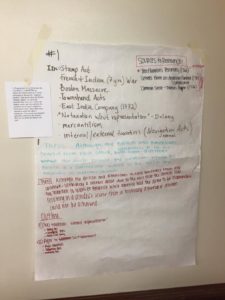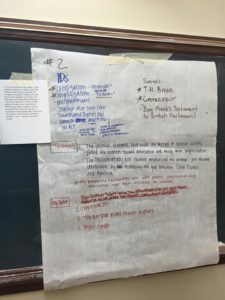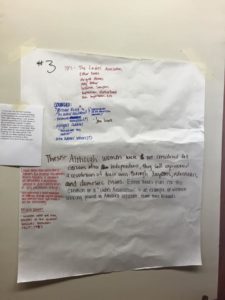Preparing students for exams used to stress me out. I used to do what many novice teachers do: I had students come up with a list of questions they could ask the day before the exam. This was an unsatisfactory experience, to say the least. These exam prep sessions were exhausting. I answered a ton of questions and review sessions turned into back-and-forths about minutiae. No matter how hard I tried, some students wanted to focus on the smallest details, ignoring the big ideas I wanted to emphasize. I needed to find a better way to prepare students for exams.
The solution emerged when I was no longer in control of my own course. As a supplemental instructor for Dr. Robert Olwell’s early U.S. History survey, exam prep fell on me. No longer concerned with creating lectures, in-class activities, etc., I could devote myself to developing a student-centered exam prep activity. I ultimately decided that a gallery walk was the way to go.
A bit about the structure of Dr. Olwell’s exam before we get to the review activity. His tests had two parts: identifications (IDs) and an essay. IDs were important terms, people, events, etc. covered in the course and counted for 25% of the exam grade. The essay was worth the remaining 75% of the grade. Dr. Olwell, with TA input, came up with four questions based on the material covered in lectures and readings. On exam day, Dr. Olwell rolled a die to determine the two exam questions students could pick from. To be ready for the exam, then, students only had to study for three of the four questions. If there was one question they didn’t like, students didn’t have to study for it.
To prepare for the gallery walk activity, I procured the following supplies: butcher paper; masking tape; and markers.
What I then did was this.
Set-Up
- I got the the room early. I hung up four pieces of butcher paper on the wall, which I had already numbered #1, #2, #3, and #4. These needed to be spaced out to give students room to work.
- I taped the four questions next to the corresponding piece of butcher paper.
- Once students settled in, I gave them each a number, from 1 to 4. When everyone had a number, I asked them to get up and go to their respective stations. I handed each group markers.
The Activity
- Students’ first task was this: to brainstorm — and list on the butcher paper — IDs that were related to their station’s question. I encouraged students to go through their notes and readings to come up with IDs. (5-to-7 minutes)
- When time was up, I had students stop what they were doing and move clockwise to the next station. Now, at a new question, students listed primary or secondary sources that could be referenced, explained, and/or analyzed in their responses. (5-to-7 minutes)
- Students rotated again. Since we wanted students to come up with their own arguments, the gallery walk’s next step was for groups to write a preliminary thesis. (10-to-15 minutes)
- Another rotation. Students had to revise, or expand on, the previous group’s thesis statement. Sometimes, groups wrote another, competing thesis. (7-to-10 minutes)
- One last rotation and task: students had to brainstorm several main points that supported the thesis statement. (10-to-12 minutes)
I remained an active presence during all of this. If students were struggling with a question, I helped them get going in the right direction. Once they were moving along, I circled the room to check on other groups.
In these 50-minute review sessions, students had the opportunity to think about, and start to answer, each of the four essay questions that could be on the exam. Since students had worked together, I encouraged them to photograph the pieces of butcher paper. Students still had a fair amount of work left to do, but they had a jump start on studying.
I led this activity for four of Dr. Olwell’s exams. In a course of 218 students, only 30 students came to the review sessions for the first exam. By the final exam, attendance had skyrocketed to over 100 students. My teaching evaluations confirmed what these numbers hinted at. One, for example, read: ‘[a]fter attending just one of [Chris’] sessions, I was able to significantly better my performance on exams.” One student even thought that the gallery walk was “fun.”





This is a great idea! I adapted this for the review in my history survey course yesterday and I think it worked really well. Thanks for sharing it.